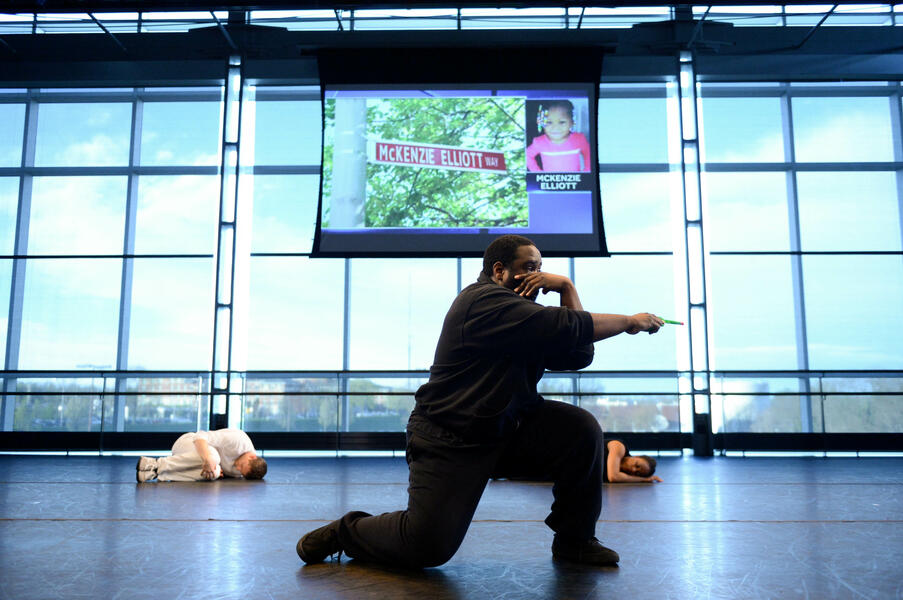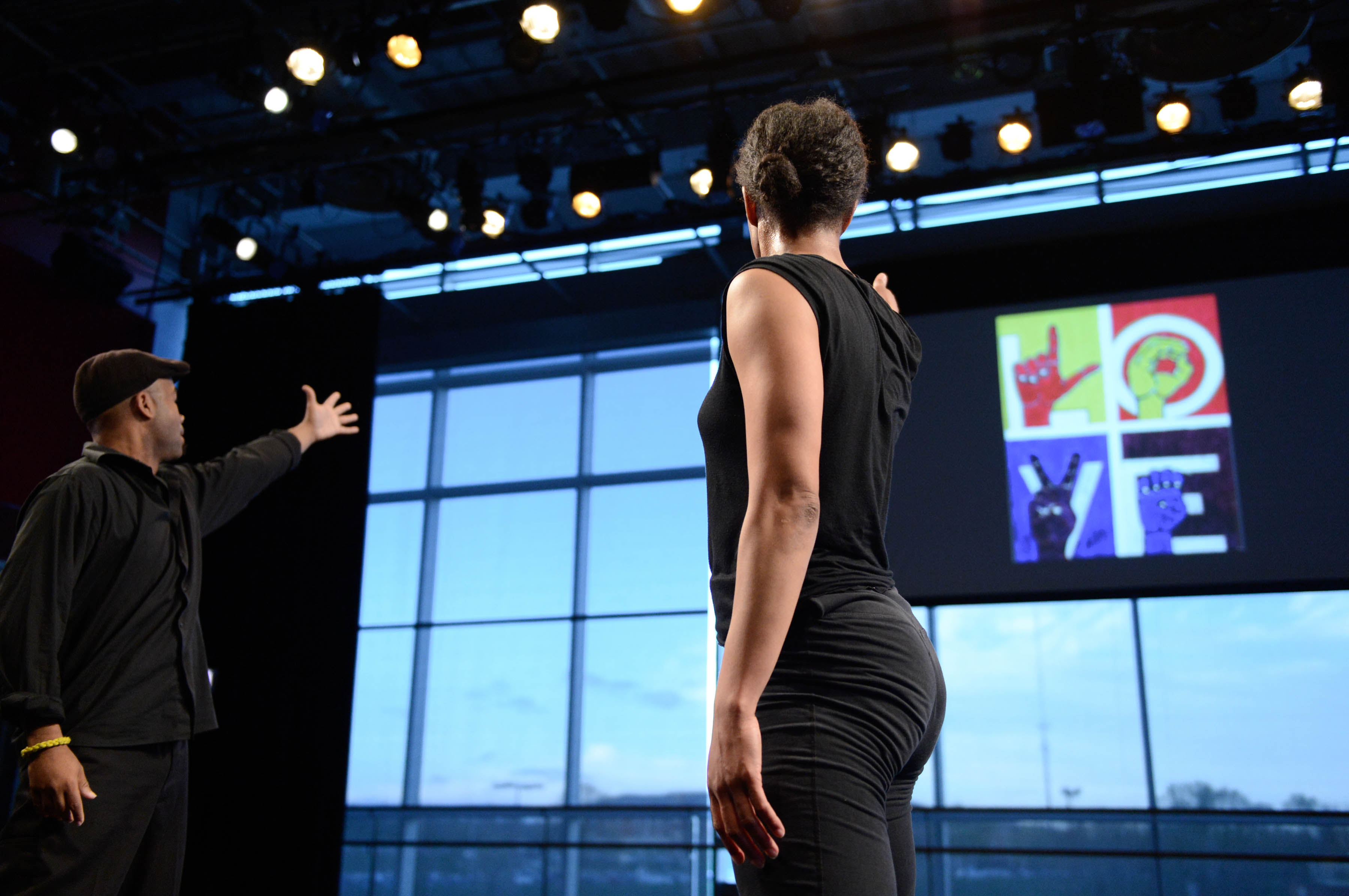Work samples
-
Visceral (Heroes and Villains)Our society is currently challenged to consider how violence has become the de facto response to the unknown, and how that fact is contributing to the systematic oppression of people we call neighbors and fellow citizens. Visceral, the first movement of a series of vignettes entitled Heroes and Villains, deals with the experience of discrimination,and the question of what path we might take to change. Breai Mason-Campbell directed, and performs in this piece.
-
Dancing White (Compilation)From generation to generation, Dancing White chronicles the interaction between blacks and whites in this country, as we together built what it means to be American. At a time in history when concerns about race relations in America have returned to a central position in the public sphere, Dancing White is an examination of our cultural norms through the lens of dance. Breai Mason-Campbell directed, and performs in this piece.
About Breai
Breai Michele is a Baltimore native, community activist, teacher, dancer, and cultural counselor. A Harvard graduate, Breai’s Master’s Thesis explored the role of Hip-Hop as a religious and moral touchstone for African American youth. In 2001, she was selected as a contributor to the Boston Healing Landscapes project with Boston University School of Medicine where she conducted research into the connection between mental health in young women and exposure to the norms espoused by popular… more
Heroes and Villains
The first movement of Heroes and Villains, Visceral deals with the how we are each seen in the world, and the role that plays in our quality of life. The audience is challenged to ask the hard questions that challenge our assumptions, and, further, to commit to remain present for the sometimes harder answers. The dancers begin in a privilege line, making visible the structural inequities which sometimes obscure the root causes of social ills. Through solo performance, partner dance, mirroring and contrast, the story of each character is communicated through movement. In the development of this piece, the dancers discussed the ways in which we feel empowered or disempowered in our daily lives, and collaboratively constructed choreography to illustrate that narrative.
The second movement, Vulnerability, is designed to evoke deep emotion, and deals with the questions each of us have about our role in change, and our complicity in the problems we now face in our society. In the wake of staggering numbers of murders in Baltimore, questions of police brutality, and omnipresent, de-facto segregation, often based on fear or the desire for safety, slowing down snap decisions and revealing the depth of individual lives is our task in this work. Mason-Campbell completed this work with an intentionally cross-cultural ensemble, which discussed the pain each member experienced in this cycle of violence, and hopes for change. The choreography tells that story.
The last movement of this piece deals with Vision, the third of a three-tiered, arts-based, community development methodology that Mason-Campbell upholds thorough practice, performance, and the passing on of folk dance traditions. The choreography considers the downfalls of conformity and assimilation as community ideals, and invites the silenced to speak.
-
 Gaurdian-2833.jpgDirector Breai Mason-Campbell grapples with our attitudes towards violence in the second movement of Heroes and Villains, "Vulnerability."
Gaurdian-2833.jpgDirector Breai Mason-Campbell grapples with our attitudes towards violence in the second movement of Heroes and Villains, "Vulnerability." -
Heroes and VillainsIn this piece, Guardian recommends actions to address the crises of racial tensions in Baltimore and beyond. With this work, we suggest that by challenging our visceral reactions to people's differences, being vulnerable before one another, and developing a vision of how we can work and live together, we can overcome the challenges of our time. In three vignettes, the company illustrates the possibilities of this process.
-
 Gaurdian-3201.jpgDirector and choreographer Breai Mason-Campbell outlines a methodology for overcoming systemic oppression, steps to counter segregation, and a path toward healed relationships in the final movement of Heroes and Villains, "Vision."
Gaurdian-3201.jpgDirector and choreographer Breai Mason-Campbell outlines a methodology for overcoming systemic oppression, steps to counter segregation, and a path toward healed relationships in the final movement of Heroes and Villains, "Vision."
Dancing White
Act 1: Join, Or Die
...is a window into the impact of the African Slave Trade on the body, and its expression through dance.
Act 2: For Sale
...illustrates the divorce between consciousness, memory and movement.
Act 3: New Negro (Old America)
...raises questions about the limits to freedom imposed upon bodies depending on their hue.
Act 4: I AM A MAN!
...reclaims the freedom in the body.
Act 5: Explicit Content
...looks at the role market forces play in physical expression and, by extension, community culture.
Act 6: #BlackLivesMatter
...connects the dots of cultural appropriation to lay the groundwork for change, today and tomorrow.
-
Dancing WhiteThe dancing body is an archetype of freedom: primal, unencumbered, poetic. In the wake of a resurgence of international attention to ongoing racial tensions, from #BlackLivesMatter, to the campaign trail to the American election, Dancing White joins the conversation by asking whether such freedoms are available to all bodies, or only those of a certain hue?
Cultural Preservation: Lindy Hop
Lindy was the official dance of the New Negro Movement: the redefining of what it meant to be black following the period of enslavement and Civil War in America. It was the physical embodiment of freedom. Named for Charles Lindbergh who defied expectations and gravity in his "hop" across the Atlantic, Lindy's airsteps, and frenzied renderings of jazz melodies express the unexpected and amazing power of a people up from oppression.
By practicing, performing and passing on Lindy Hop, Breai Mason-Campbell works to repair African American culture by building self-knowledge and self-respect. This piece features 3 junior dancers who are being mentored by Mason-Campbell, and is a part of a hand dance presentation- creating a family tree of origins for a people often denied the dignity of lineage.
-
Guardian's NMAAHC PerformanceGuardian was honored to perform for the grand opening of the National Museum of African American History and Culture in Washington, D.C. Based on the great works of Whitey's Lindy Hoppers, who made swing dance famous at the 1939 World's Fair, Guardian presented a traditional, high-energy choreography, preserving a legacy that faces extinction in the African American community. Lindy Hop, born in Harlem and raised in its streets and ballrooms, has become the pride of Sweden, now renowned for the best teachers and dancers. Guardian's mission is to study, perform and pass on this African American cultural treasure as a matter of cultural integrity.
Self Knowledge=Self-Love
Through anecdotal inquiry and community conversations, opinions of Africa were found to be related primarily to poverty, sickness and ignorance. Mason-Campbell set out to investigate the beauty of Africa through movement with her students in Sandtown in order to rectify these assumptions and repair distorted identities. The music video attached is a tribute to the intersection of the past and the future present in the lives of black Americans.
-
Teach Me How To Kuku (Official Video 2011) by New Song Academy 1st GradeThis music video is a remix of a popular song "Teach Me How to Dougie" revised to explore the connections between Africa and African Americans. Parents, community members and children in Sandtown were exposed to elements of African culture and invited to celebrate the presence of that rich history in their lives.
Desegregation through the Arts
This piece features student dancers from a predominately black, isolated community, yet the finale welcomes allies and those interested in repairing the damage done by separation to the stage to celebrate unity and possibility.
-
You Can't Stop The Beat (Community Movement)The ideals raised in American, public consciousness by the Civil Rights Movement remain the subject of our conversations today as we work to bridge the divide between disparate communities here in Baltimore and beyond. This Community Movement project invited white allies to work in Sandtown, Baltimore on the issue of desegregation and equal access to resources. Through dance, students express the possibilities of community, and the first steps on the road to change.
Dance for Social Change in Baltimore
North
Lindy Hop is often lauded for its important role in desegregation. Harlem's Savoy Ballroom opened its doors to dancers from beyond the boundaries of Harlem during Jazz's heyday, boasting the first integrated, public, social space in, perhaps, the world. This history is reflected by the make up of the company in this performance. Breai Mason-Campbell's commitment to bringing the Arts to communities without ready access to theaters, or performance experiences is met here, in a school gym in Sandtown.
North opens with a montage of images from the Great Migration, then erupts into a frenzy of celebratory, swing dance movements. The work ends with a Cakewalk- historically, a comedic portrayal of slave masters by enslaved Africans, here, a dig at the bourgeois culture of Harlem's upper crust.
Closer
Heritage was a key concern in the development of this piece, as some folk expression is seen as a product of fad rather than as key, cultural information which needs to be remembered and passed down. As jazz music maintains its place in the American canon as foundational, so must the vernacular, jazz dance which is its partner in order that the bodies who found liberation through those movements maintain access to freedom.
Pairing Locking and Popping with Lindy Hop and Jazz invites audiences to remember generationally as a building block to creating awareness of a legacy which extends beyond the present moment.
-
Closer (Community Movement)Locating Art in the community to which it is indigenous is one of Guardian's top priorities. Our Community Movement series is an annual undertaking designed to celebrate the contributions that black people have made to American culture for audiences who may not otherwise have access to Arts performances or education. Closer is a collage of vernacular traditions spanning the distance between the period of Reconstruction to the Millennium.


